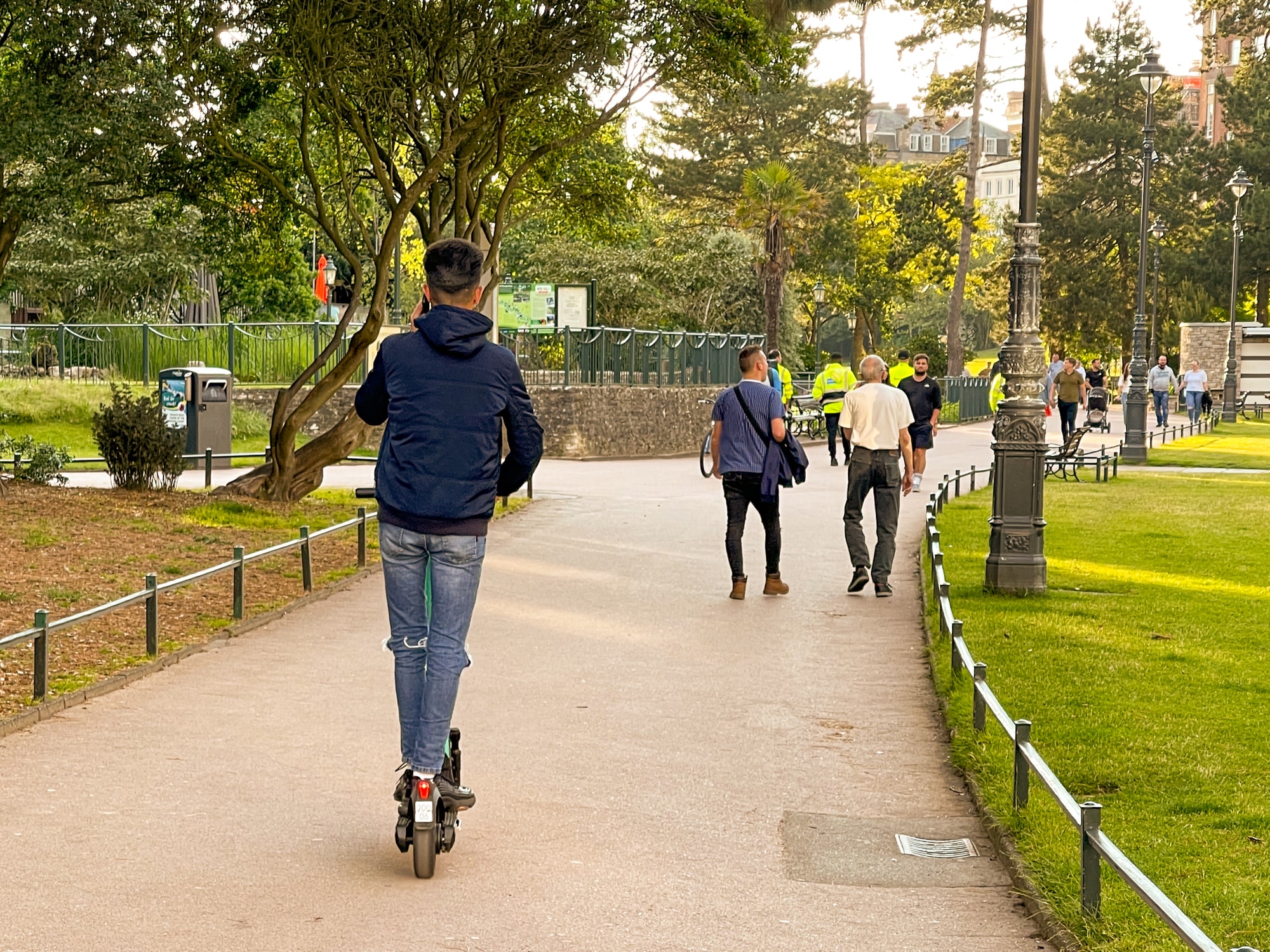Table of Contents
When the UK legalised electric scooter rentals in June 2020, our lives suddenly became even more convenient. Whether you live in London, Birmingham or Yorkshire, you probably see e-scooters wherever you go.
It’s no secret that they’re trendy, and for a good reason! Electric scooters are cheap to run, sustainable and kind to the environment. They’re also a lot easier to maintain and store than cars or e-bikes.
With enthusiasts encouraging the UK to legalise privately owned electric scooters, we decided to pay homage to the forward-thinking countries our government can take inspiration from.
These countries allow people to buy and use their electric scooters on cycle paths and, in some cases, public roads.
Let’s dive straight in!
Belgium

As one of the first countries to embrace e-scooters, Belgium is paving the way for other countries to include a sustainable mode of transportation to their roads. The law in Belgium states that you can drive an e-scooter as long as it doesn’t exceed a maximum speed of 25 km/hour.
If you wish to ride at top speeds, you’ll need to get a drivers license, but the laws are relatively relaxed compared to other countries.
Surprisingly, according to Statista, 44% of e-scooter users in Brussels are 25-34 years old, with 35 – 44-year-olds coming in second place.
Lime is the largest provider of e-scooters in Belgium, but as privately owned models are legal, you can avoid rental costs and invest in personal light electric vehicles that will last a long time.
Buying an Electric Scooter in Belgium
If you decide to buy a private electric scooter, Belgium has some fantastic companies delivering high-powered electric vehicles at reasonable prices. One such private scooter manufacturer is Pure.
The scooters are built with convenience and practicality in mind, and each model comes with waterproof features. Our favourite Pure product is the company’s unique long-range e-scooter, which will offer a 60km range with only one charge and climb hills without losing any speed.
It’s ideal for commuters, but if you’re looking for a budget e-scooter, the Pure Air Go is great for personal use.
Fun Facts
- Authorities in the medieval city of Bruges ruled out the use of e-scooters due to the cobbled streets.
- Electric scooters are most popular in the capital city of Brussels.
Spain

If you own an e-scooter in Spain, you’ll have to comply with the same laws as car and motorbike riders. The Spanish authorities introduced strict legislation to remove the legal grey area, and other rules include scooters having a maximum speed of 25 km/hour.
Riders aren’t allowed to use their electric scooter on the pavement, motorway and city tunnels, with fines in place for people that break the rules.
The country also requires users to have a front white light and a rear red light, which is similar to the current bike laws.
Buying an Electric Scooter in Spain
If you’re looking for an innovative Spanish e-scooter company, Joyor provides foldable scooters that come in a range of colours. With most having maximum speeds of 25 km/hour, they’re perfect for enjoying riding through Barcelona or admiring the stunning scenery of Seville.
The budget A model is perfect for new riders, as it has a range of functions but prioritises usability above everything else. The G series is designed for long journeys, and it has puncture-resistant tyres with a colourful LDC display screen.
Fun Facts
- In 2019, Uber chose Madrid to launch its Jump electric scooter rental service in the first city.
- In Spain, e-scooters are incredibly popular – especially in the larger cities such as Barcelona, Madrid and Valencia. However, the country has recently introduced traffic rules to protect pedestrians and other road users.
- Spain estimates there are around 100,000 PEV owners in the country. While there are no official figures, this shows the rising popularity of privately owned e-scooters.
Germany

Germany is known as one of Europe’s most forward-thinking countries, so it’s no surprise that they were one of the first to make private e-scooters legal. However, there are strict laws for both shared and privately owned electric scooters.
If you use an e-scooter in Germany, you can’t exceed 20 km/hour, lower than the Spanish and Belgian limit of 25 km/hour.
Each scooter must also have a comprehensive braking system, use both a front and rear light, and be easy to control.
Users will also be required to obtain an operating license, and failure to do so results in a fine of 70 Euros. Private owners must have a valid insurance policy and display their insurance sticker on the back of the PEV.
Further to these restrictions, riders can only use designated cycle paths and lanes.
Buying an Electric Scooter in Germany
Electric scooters in Germany are strictly regulated, but some unique manufacturers define high-quality private scooters. Our favourite is Metz Moover – the e-scooter brand with a focus on safety.
Designed for commuting and speedy travel, the scooter meets all of Germany’s legal requirements, and it also has a walking mode, which enables you to travel at 6 km/hour. Better still, the design is flawless and perfect if you want a sleek scooter.
The compact nature also means you can take the scooter on public transport, and it’s easy to navigate through cycle lanes.
Fun Facts
- Research from the German statistics company Destasis in 2020 showed that e-scooters represented only 1% of all traffic accidents, which shows how safe they are compared to other gas and electric motor vehicles.
- Germany first legalised the use of e-scooters in May 2019.
The USA
We can attribute the growth of micro-mobility rentals to the USA as it was one of the first countries to embrace the more sustainable and convenient mode of transportation. However, the USA is a vast country, and each state has its own set of laws that are challenging to understand.
So we’re going to look at the states with the most precise e-scooter legislation in place.
California
In California, you can ride an e-scooter as long as it doesn’t exceed 15 miles per hour. Riders must always use the cycle lanes unless there isn’t one available, or they need to turn right. Only one person is permitted to ride a scooter, which is pretty much the same law as everywhere in the world.
Where California differs is its age restrictions and licensing rules. If you’re under the age of 16, you can’t operate an e-scooter, but you also need to have a learners permit. A rider can wear reflective vests in place of using front and rear lights on their scooter.
New York City
It makes sense that New York City has embraced e-scooters because driving around the city is an absolute nightmare that many residents try to avoid. The city has laws in place that permit people over the age of 16 to ride an e-scooter, as long as they don’t exceed 20 mph.
People under the age of 18 must wear protective gear when using their electric scooters, but if you’re 18 and over, you can use them without a helmet – although we’d always advise that you prioritise safety first.
Michigan
Instead of having a specific electric scooter law, Michigan groups all-electric micro-mobility modes of transportation together. Both electric skateboards and scooters have a maximum speed restriction of 25 mph, and people can use public roads.
In Michigan, you can use your PEV on the sidewalk and other pedestrian areas but must give the right of way to other people. Riders under the age of 19 must wear protective gear (especially a helmet).
Illinois and Indiana
Illinois and Indiana have similar laws for electric vehicles, including restrictions on riding a scooter through cultural trails and sidewalks. People aged 16 and over can use scooters, but they must have a valid learners permit.
All e-scooters must have both a front headlight and rear red lights, but while guidelines recommend helmets, they’re not required by law.
Buying a Scooter in the USA
The USA has many forward-thinking e-scooter brands, including the incredibly successful Razor scooters, but we love the EMOVE range from Voro Motors. The company specialises in electric bikes and scooters, and there are plenty of models to choose between.
If you’re looking for a long-range scooter, the EMOVE cruiser is the best in the world and a worthy investment if you want to commute to work each day. Just one charge provides you with over 60 miles of run time, and EMOVE recently announced plans to release a roadster scooter, which promises even better performance features.
We can’t wait to see what this innovative brand comes up with next!
Fun Facts
- Between 2003 and 2019, the Razor brand sold 13 million electric scooters.
- In the USA alone, the number of PEV riders increased from 84 million in 2018 to 136 million in 2019 (Bloomberg CityLab)
- People in the US expect the average price of an e-scooter to drop from $700 t $500 in the future.
Norway

Norway is one of the best places to live globally, and the country pays special attention to providing the best lifestyle for residents. Like its Scandinavian cousins, Sweden and Denmark, there’s an emphasis on sustainability, so it makes sense that the country has embraced e-scooters.
You should be aware of some strict rules if you want to enjoy the dramatic Norweigan scenery on your privately owned electric scooter.
Only one person is allowed on a scooter at once, and there are clear signs that state where your scooter can be legally ridden. While you can use the pavements, you’ll receive a fine if you exceed 6 km/hour, and there are also parking fines if you leave your scooter in specific locations.
Surprisingly, there’s no age limit in Norway, and the country is yet to introduce a zero drink driving law, but these will likely happen in the future.
Buying an E-Scooter in Norway
When it comes to PEV’s in Norway, Inokim is probably the most recognised brand, and there is an extensive range of innovative designs. The Inokim Mini-2 is the lightest e-scooter you’ll find, but there are sturdier models such as the OXO, which is more suited to long-range and off-road riding.
Sweden

Sweden also has vague laws regarding electric scooters, with the maximum speed being 20 mph. You’re allowed to ride a scooter on the road, but you should use bike lanes wherever possible. If you have a high-powered model, you can only use it on private land and fenced areas.
People aged 15 and over can have an e-scooter, and there are no protective laws in place, but the authorities do recommend that you wear a helmet.
The Most Popular Electric Scooter Brand in Sweden
E-scooters are relatively new to Sweden, but innovative brand VEIO creates each electric vehicle with sustainability in mind. The foldable model RS is probably the most popular in VEIO’s range, and it comes with a long-range lithium battery.
The best feature of this scooter is its powerful motor, which can climb up hills.
France
France is another country embracing electric scooters, but the government recently updated the laws to improve road safety. People cannot use e-scooters that exceed the speed limit of 25 km/hour and will incur a fine of 1500 if they own a higher-powered e-scooter.
It’s also illegal to use private scooters on the pavement, and you must make sure any model you purchase has front and backlights, with a bell, braking system and reflectors.
Buying an E-Scooter in France
Trottix is the most forward-thinking French micro-mobility manufacturer, and its range of e-scooters is undoubtedly impressive. If you like sleek designs with unique elements, you’ll love the TX1 collection, which embodies French sophistication.
The scooters also adhere to French regulations and have a superior braking system, lights and a warning bell.
Fun Facts
- In 2020, electric scooter sales in France overtook e-bike sales. The sales increased from 478,000 in 2019 to 640,000 in 2020 (BikeEU)
- In 2019, the French government changed scooter usage laws due to accidents in high-traffic pedestrian areas.
Singapore
As one of the world’s largest business hubs, it’s no surprise that Singapore allows people to purchase and ride electric scooters. However, to protect pedestrians and promote road safety, the government has some strict laws in place.
The Land Transport Authority must approve any electric mode of transportation you purchase in Singapore, and there are restrictions regarding the speed and specs of e-scooters. Limitations include scooters not exceeding a 25 km/hour speed, and each model must have a maximum weight of 20 kg.
Singapore dishes out heavy penalties if you don’t adhere to these laws, including a fine of $10,000 and, in severe cases – up to six months jail time.
You’ll also need to register your scooter and display your registration and safety mark on your scooter. The country allows people to ride on public paths but recently introduced a theory test for all riders, and failure to obtain a pass certificate could result in jail time and fines.
In Singapore, people cannot use their e-scooters on footpaths, and there are implications if you use mobile phones or other devices.
As you can see, Singapore has perhaps the strictest laws surrounding e-scooters and all micro-mobility vehicles.
Buying an Electric Scooter in Singapore
It’s essential to remember that the LTA must approve any electric scooter you purchase in Singapore, so you should find a reputable manufacturer. Most e-scooters in Singapore come from wholesalers, so it’s always a good idea to shop around.
Two of the best LTA approved scooters come from both Imokim and Segway are examples of superior design, with excellent safety features. There are plenty of other models available, but remember to check the specs of each scooter before purchasing.
Fun Facts
- In 2019, e-scooters in Singapore took a significant hit when the government banned their use on footpaths. While they’re still popular in the country, the change in law meant people had to stick to cycle and park paths only.
- The government encouraged scooter users to switch to bikes, which increased e-bike accidents on public pathways.
Will The UK Ever Make Private Electric Scooters Legal?

There are so many things for governments to consider when it comes to electric scooters. Still, with all of their benefits, it seems inevitable that countries will continue to make accommodations for privately owned e-scooters.
While there will always be some safety implications, it was precisely the same with cars many years ago. Society adapted to motor vehicles because they were a convenient mode of transportation, and PEV’s will likely pave the way for a more sustainable future.
It’s only a matter of time before the UK government follows the example of the countries on this list, and we can’t wait to see how electric scooters change the way we live, commute and protect our environment.
Don’t forget to follow our blog for the latest tips for new e-scooter riders and exclusive information on new brands.

